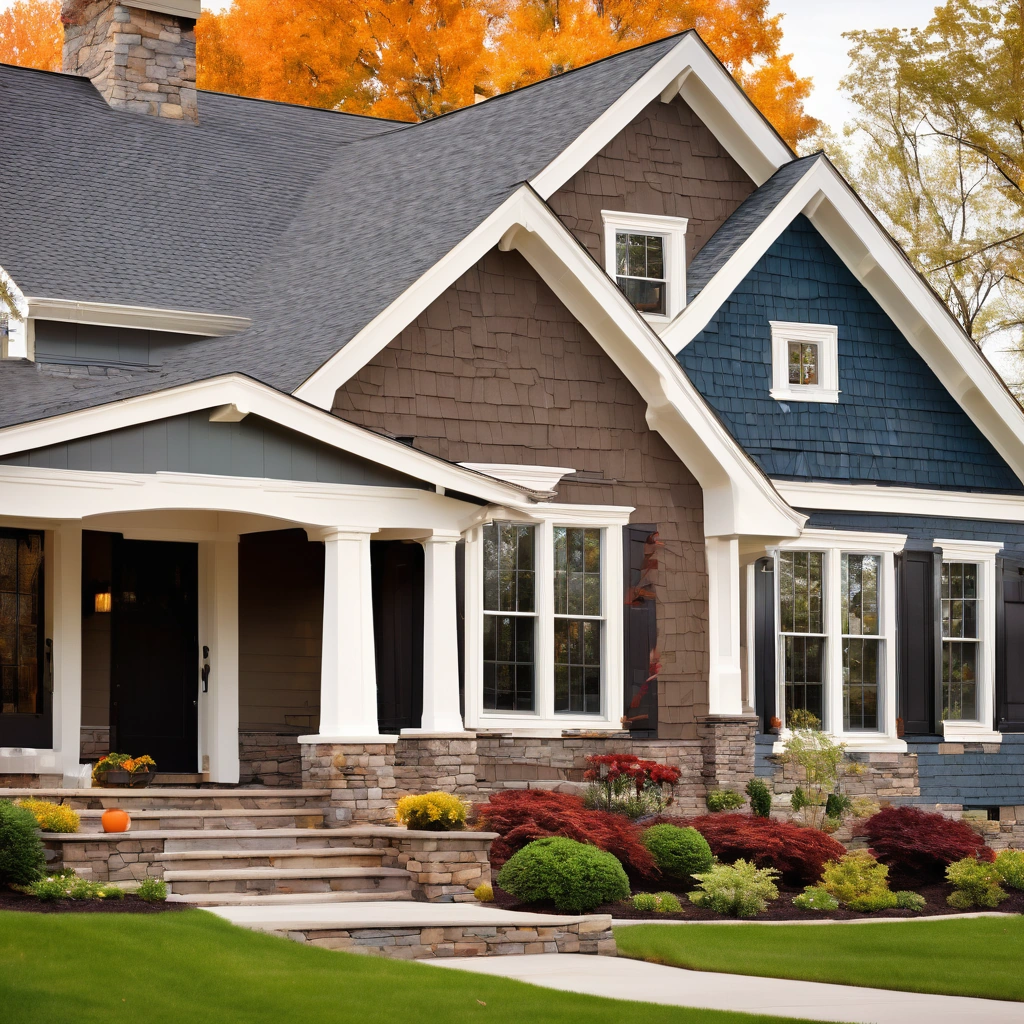Selecting the Perfect Siding Color: A Homeowner’s Guide to Boosting Curb Appeal and Property Value
The Power of Siding Color: More Than Just a Pretty Facade
The quest for the perfect home is a journey paved with countless decisions, large and small. Among the most impactful, yet often overlooked, is the selection of siding color. More than just a cosmetic choice, siding color is a powerful statement that shapes perception, influences property value, and contributes to the overall aesthetic harmony of a neighborhood. Like choosing the right suit for a job interview, selecting the perfect siding color is about making the best first impression.
It’s about understanding the unspoken language of color and how it communicates your home’s personality to the world. This comprehensive guide delves into the art and science of siding color selection, providing homeowners with the knowledge and tools to transform their homes into curb appeal masterpieces. From understanding the psychology of color to navigating HOA restrictions, we’ll equip you with the expertise to make a confident and informed decision that will enhance your home’s beauty and boost its resale potential.
In the competitive real estate market, curb appeal is paramount, and the house siding color plays a starring role. A fresh coat of paint or new siding in a well-chosen hue can dramatically increase home value. Real estate professionals consistently emphasize the importance of exterior presentation, noting that homes with attractive siding color often sell faster and at higher prices. According to a recent study by the National Association of Realtors, homes with expertly executed exterior design, including siding color choices that complement the architectural style, can see an increase in perceived value of up to 10%.
This underscores the significance of thoughtful siding color selection as a strategic home renovation investment. Beyond the financial implications, the right siding color can significantly impact the emotional connection potential buyers feel towards a property. Color psychology suggests that certain hues evoke specific emotions and associations. For instance, a warm, inviting color palette might create a sense of comfort and security, while a bold, modern choice could project sophistication and style. When considering exterior design, it’s essential to think about the message you want your home to convey.
Are you aiming for a classic, timeless look, or a more contemporary, cutting-edge aesthetic? The siding color you choose will be instrumental in achieving your desired effect. Moreover, the interplay between siding color and landscaping elements further enhances curb appeal, creating a cohesive and visually pleasing exterior. Furthermore, the trend towards sustainable siding and energy-efficient siding options adds another layer of complexity and opportunity to the color selection process. Lighter siding color shades reflect sunlight, reducing heat absorption and potentially lowering energy bills, contributing to a more environmentally friendly home. As homeowners become increasingly conscious of their carbon footprint, opting for sustainable siding materials in complementary colors becomes a powerful statement. This guide will explore these eco-conscious choices, providing insights into how you can enhance your home’s beauty while minimizing its environmental impact, all while navigating potential HOA restrictions that may influence your final siding color decision.
Decoding Color Psychology: How Hues Impact Home Value and Aesthetics
Color is a language, and your home’s exterior speaks volumes. Understanding the psychology of color is crucial for selecting a siding hue that not only appeals to your personal taste but also resonates with potential buyers and complements the surrounding environment. For example, blues and greens often evoke feelings of tranquility and stability, making them popular choices for suburban homes aiming for a classic, welcoming vibe. In contrast, warmer tones like beige, cream, and light grays project a sense of sophistication and timeless elegance, often favored in upscale neighborhoods.
Darker colors, such as charcoal gray or navy blue, can create a dramatic and modern look, but they also absorb more heat, which can be a consideration in warmer climates. Real estate professionals often advise homeowners to consider neutral palettes for maximum resale appeal. A study by Zillow found that homes with gray exteriors tend to sell for more than comparable homes with other color schemes. However, it’s essential to strike a balance between neutrality and personality.
A splash of color on the front door or trim can add character without compromising broad appeal. Remember, the goal is to create a cohesive and inviting exterior that enhances the perceived value of your property. The impact of siding color extends beyond mere aesthetics; it directly influences curb appeal and, consequently, home value. Consider the emotional response different colors elicit. Red, for instance, can convey energy and excitement, but may be overwhelming as a primary house siding color.
Conversely, earth tones like browns and muted greens often create a sense of groundedness and harmony with nature, enhancing the perceived value, especially in areas with lush landscaping. Moreover, the interplay between siding color and architectural style is paramount. A brightly colored, modern siding might clash with a traditional Victorian home, diminishing its charm and potentially impacting its real estate value. Careful consideration of these factors is crucial during any home renovation project. Furthermore, the principles of color psychology are deeply intertwined with exterior design and can significantly influence potential buyers’ perceptions.
A well-chosen siding color can highlight architectural features, create visual interest, and even make a smaller home appear larger. For instance, using a lighter siding color on the upper stories of a two-story house can visually lift the structure and create a sense of height. Conversely, darker colors can ground a house and make it appear more substantial. When selecting a siding color, consider the surrounding landscape and the colors of neighboring homes. The goal is to create a cohesive and harmonious exterior that complements the environment and enhances the overall curb appeal.
Finally, homeowners should also be aware of any HOA restrictions that may govern siding color choices. Many HOAs have specific guidelines regarding acceptable colors and materials to maintain a consistent aesthetic within the community. While these restrictions may seem limiting, they can also help protect home value by preventing homeowners from making drastic or unconventional choices that could detract from the overall curb appeal of the neighborhood. When exploring siding color options, it’s also wise to consider sustainable siding and energy-efficient siding materials. Lighter colors reflect more sunlight, reducing cooling costs, and opting for materials with recycled content can minimize environmental impact, appealing to eco-conscious buyers and enhancing the long-term value of your property.
Architectural Harmony, Climate Considerations, and HOA Hurdles
Selecting the right siding color transcends mere personal preference; it’s a strategic decision impacting curb appeal, home value, and the overall aesthetic harmony of your property. This choice necessitates a careful balancing act between architectural style, regional climate considerations, and adherence to homeowner association (HOA) guidelines. A Victorian-era home, for instance, often benefits from historically accurate or softer pastel shades that accentuate its intricate details, enhancing its period charm and potentially increasing its real estate value within a niche market.
Conversely, a modern, minimalist dwelling might leverage bolder, contemporary siding colors like deep grays or even strategically applied black to highlight clean lines and geometric shapes, creating a striking visual statement that appeals to a different segment of potential buyers. The success of any home renovation hinges on understanding these nuances. Climate plays a pivotal, often underestimated, role in siding color selection. In warmer climates, lighter siding colors are generally preferred due to their higher solar reflectance, which helps to minimize heat absorption and reduce cooling costs.
This directly translates to energy-efficient siding and lower utility bills, a significant selling point for environmentally conscious buyers. However, in colder climates, darker siding colors can absorb more solar heat, potentially reducing heating costs. This benefit must be weighed against the increased risk of fading and the potential need for more frequent repainting or replacement. Therefore, selecting durable, fade-resistant materials becomes paramount in colder regions to maintain curb appeal and long-term home value. The interplay between color psychology and climate considerations is a crucial aspect of exterior design.
Navigating HOA restrictions often presents the most significant hurdle in the siding color selection process. Many HOAs maintain stringent guidelines regarding acceptable house siding colors, often limiting homeowners to a pre-approved palette designed to ensure neighborhood uniformity. Before investing time and resources in exploring specific siding color options, it’s imperative to meticulously review your HOA’s guidelines and understand any limitations or approval processes. Non-compliance can result in costly fines and the unwelcome prospect of redoing your siding.
While some HOAs may allow for exceptions, securing approval typically requires a well-documented proposal demonstrating how your chosen siding color will enhance the overall aesthetic of the neighborhood and not detract from property values. Presenting a cohesive exterior design plan that considers the existing architectural landscape is often key to a successful appeal. Beyond aesthetics and regulations, the choice of siding color also presents an opportunity to embrace sustainable siding practices. Opting for lighter colors not only reduces cooling costs but also contributes to a more energy-efficient home, aligning with growing consumer demand for environmentally responsible choices. Furthermore, selecting siding materials with high recycled content or those that are sustainably sourced can further enhance your home’s green credentials. As the real estate market increasingly values sustainability, these choices can positively impact your home’s long-term value and appeal to a broader range of buyers. By carefully considering these factors, homeowners can transform their house siding into a valuable asset that enhances both curb appeal and property value.
A Step-by-Step Guide to Color Selection: From Inspiration to Implementation
Choosing the perfect siding color can feel overwhelming, but a systematic approach can simplify the process and ensure a satisfying outcome, ultimately boosting curb appeal and potentially increasing home value. Start by gathering inspiration. Browse online resources like Pinterest and Houzz, and take note of homes in your neighborhood that you find appealing. Pay attention to the colors that resonate with you and how they complement the architectural style of the homes. Consider also the interplay between landscaping and house siding.
A vibrant garden, for example, might pair beautifully with a neutral siding color, creating a balanced exterior design. Next, utilize online visualizers offered by siding manufacturers like James Hardie and CertainTeed. These tools allow you to upload a photo of your home and experiment with different siding colors, trim options, and roofing materials. This is an invaluable step in the home renovation process, allowing you to virtually assess how different color palettes impact your home’s overall aesthetic.
Don’t underestimate the power of contrast; consider how different siding color choices interact with existing architectural features like windows, doors, and trim. Visualizers also often incorporate regional palettes, offering suggestions that align with local real estate trends and color psychology norms. Once you’ve narrowed down your choices, order physical samples of your top contenders. Viewing colors online can be deceiving due to variations in screen calibration and lighting. Physical samples allow you to see the colors in natural light and assess how they look against your existing roofing, trim, and landscaping.
Place the samples against different areas of your home at various times of day to observe how the color shifts with the changing sunlight. This step is crucial, as the perceived siding color can vary significantly based on lighting conditions and surrounding elements. Remember that even subtle shifts in hue can dramatically impact curb appeal. Consider the long-term maintenance requirements of your chosen color. Lighter colors tend to show dirt and mildew more easily, potentially requiring more frequent cleaning, while darker colors may fade more quickly in direct sunlight, impacting the longevity of your home’s exterior design.
This is particularly relevant when considering the impact on home value. Also, explore the availability of sustainable siding options. Materials like fiber cement offer excellent durability and require less frequent repainting, reducing long-term maintenance and environmental impact. The choice of energy-efficient siding can also play a key role in long-term cost savings and contribute to a greener home. Talk to local contractors and ask about their experiences with different siding colors and materials. They can provide valuable insights into the durability and maintenance requirements of various options, as well as any potential challenges associated with installation.
Local contractors are also familiar with common HOA restrictions in your area and can advise you on colors that are likely to be approved. Understanding these regulations is crucial to avoid costly delays or rejections. Finally, don’t be afraid to seek professional advice from a designer or color consultant. They can help you navigate the complexities of color theory and create a cohesive and visually appealing exterior that reflects your personal style and enhances your home’s value, leading to a significant return on investment when it comes time to sell.
Sustainable and Energy-Efficient Options: Building a Greener Home
In an era of heightened environmental awareness, sustainable and energy-efficient siding color options are gaining traction. Lighter colors, as previously mentioned, reflect more sunlight and can help reduce cooling costs, but the material itself plays a crucial role. Opting for siding materials with high recycled content, such as certain types of fiber cement or composite siding, can minimize your environmental footprint. Consider the long-term durability of your chosen siding material. Siding that lasts longer requires less frequent replacement, reducing waste and conserving resources.
Look for siding products that are certified by organizations like the Forest Stewardship Council (FSC) or the Green Building Council. These certifications ensure that the products meet specific environmental standards. As the South China Morning Post has reported, sustainable building practices are becoming increasingly important in the global real estate market. Homeowners who prioritize eco-friendly materials and energy-efficient designs are not only contributing to a healthier planet but also enhancing the long-term value and appeal of their properties.
By making informed choices about siding color and material, you can create a beautiful and sustainable home that benefits both your family and the environment. Beyond recycled content, the embodied energy of siding materials is a critical consideration for environmentally conscious home renovation. Embodied energy encompasses the total energy required to extract, process, manufacture, and transport a product. Aluminum siding, while durable, typically has a high embodied energy compared to wood or fiber cement. Choosing sustainable siding options with lower embodied energy reduces the overall environmental impact of your home’s exterior design.
This is particularly relevant in the context of real estate, as potential buyers are increasingly factoring in a home’s carbon footprint. Selecting an energy-efficient siding color and material contributes to a lower carbon footprint, enhancing curb appeal and potentially increasing home value. The interplay between siding color and energy efficiency extends beyond simple reflectivity. Certain pigments used in darker siding colors can absorb significant amounts of heat, potentially increasing cooling loads. However, advancements in pigment technology have led to the development of ‘cool’ siding color options that reflect a higher percentage of solar radiation, even in darker hues.
These innovative pigments can significantly reduce heat absorption, mitigating the impact on energy consumption. When considering HOA restrictions and color psychology, explore options with your siding provider to find darker shades that offer improved solar reflectance. Balancing aesthetic preferences with energy efficiency is key to maximizing both curb appeal and long-term savings. Furthermore, the long-term performance and maintenance requirements of different siding materials directly impact sustainability. While some materials may appear eco-friendly initially, their susceptibility to damage or frequent maintenance can negate their environmental benefits over time.
For example, vinyl siding, while relatively inexpensive, can crack or fade, requiring more frequent replacement compared to fiber cement or wood siding. Consider the life cycle cost of your chosen siding material, factoring in maintenance, repairs, and eventual replacement. Investing in durable, low-maintenance sustainable siding not only reduces waste but also minimizes the need for harsh cleaning chemicals, further contributing to a healthier environment. This holistic approach to house siding selection enhances both the environmental and economic value of your home.


